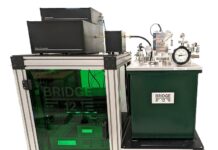
Complementary Metal Oxide Semiconductor (CMOS) technology is working quite well in IC manufacturing area and many ICs are being manufactured worldwide on daily basis. But in the foreseeable future, many problems similar to low-leakage current, integration density, heat generation, high price and many more will arise in CMOS technology, which cannot be handled easily.
On the other side, Quantum-dot Cellular Automata (QCA) is one of the most commendable approach besides the other alternative approaches (SET, CNTFET, Carbon Nano-tubes), which has the proficiency to replace a well-known CMOS technology in near future. QCA technology possesses small size, high speed of operation, high integration density capacity and ultra-low power consumption without any leakage current problem at nano-scale level. This is the necessity at a technology level in VLSI industry that needs to be implemented for fabricating an IC at nano-scale level to sustain its own growth.
Basics of QCA Technology
QCA cell is the fundamental component in QCA technology which comprises of four quantum dots. These quantum dots inside the cell are connected through electron tunnel junction. There are four places where electrons can conform inside the cell but electrons will reside at that place which requires minimum energy. Further, both the electrons will get adjust at the uttermost distance possible between them. Columbic interaction between the electrons is used to gain the necessary computing logic states like logic ‘0’ and logic ‘1’ by utilizing the positions of electrons.



Logic from one QCA cell to another QCA cell is passed utilizing cell polarization effect and it continues in all over the circuit till the end, which indicates that there is not any kind of current is flowing in between the QCA cells. Therefore, very less power is consumed by QCA circuits when transition of the state takes place from one logic to another.
Figure 2 shows the QCA wire structure, used to pass information. Figure 3 shows QCA Inverter structure: one is simple and another is robust, considering the chances for each QCA cell to get fail, so robust structure is used whenever it is essential in the design.

The most important structure in QCA is 3-input Majority gate as shown in Figure 4. This gate is important and works as a fundamental gate because any other logic structures like AND gate, OR gate or others can be formed utilizing the 3-input majority gate. By converting one of its three inputs from +1 to -1 logic, AND gate and OR gate can be formed accordingly. Both the 3-input majority gate and QCA Inverter are the basic and fundamental gates in QCA.
One can design any structure by utilizing only an Inverter and Majority gates in QCA approach, taking the help of a QCADesigner tool. It is an open access tool which is freely available online.
QCA Clocking:
All QCA circuits requires a clock which provides power to run the circuits besides providing synchronization and controlling over the information flow through QCA wires. Four phase clock signals are required for performing QCA computation. The clock consists of four phases: hold, release, relax and switch [6], and its also known as Landauer Clocking as shown in figure. 5. Each phase has lag of 900 w.r.t. its next stage.
During the switch phase, the QCA cells settles down to one of its state as logic ‘0’ or logic ‘1’ as influenced by its neighbors. During hold phase, the QCA cells maintain its current state as it is. During release and relax states, QCA cells are unpolarized which has not any effect on determining the state of QCA cell.

QCADesigner tool
QCA is an emerging concept in computational nanotechnology for the understanding of a computer using collections of nano-scale QCA cells. These QCA cells are proficient enough for performing all complex computational functions essential for general-purpose computation (majority function, Inversion, and fan-out). The QCADesigner tool facilitates prompt design, layout and simulation of QCA circuits by providing powerful CAD features available in more complex circuit design tools. This tool gives the designer the ability to quickly layout a QCA design by providing an extensive set of CAD tools. As well, several simulation engines facilitate rapid and accurate simulation. This tool has already been used several times by researchers all over the world to design full-adders, barrel shifters, random-access memories, etc. These verified layouts provide motivation to continue efforts towards a final implementation of QCA circuits.
Simple design of 1-bit Full Adder based on QCA technology
A Full Adder is a logical design that performs an addition operation on three 1-bit binary numbers. In general, the full adder produces a Sum of the three inputs (A, B, Cin) and Carry value. Cin is a Carry input here while ‘Carry’ is considered as an output carry generated.

Carry = AB + BC + AC = Maj (A, B, C)

Fabrication
Generally, there are four types of fabrication classes are defined for QCA: Metal-island, Semiconductor, Molecular and Magnetic.
- Metal-island: The metal-island is the first technology among the technologies that had been demonstrated to implement QCA technology in real world. The method consists of building quantum dots using aluminum islands with metal islands as big as 1 micrometer in dimension. The problem with this technique was that, it was not intended to compete with the existing technology as the nano-scale level. This technique is not feasible practically because of large size of metal islands which requires extremely low temperature for Quantum dot cells to work at nano-scale.
- Semiconductor: The same highly advanced technology of CMOS can be used to fabricate QCA cells. Cell polarization is encoded as charge position, and quantum-dot interactions rely on electrostatic coupling. But, current CMOS technology has not yet reached at a level where a cell can be fabricated at nano-scale level with mass production.
- Molecular: This fabrication proposes to implement the QCA cell out of single molecules. The advantage of this technology includes: highly symmetric QCA cell structure, very high switching speeds, extremely high device density, operation at room temperature, and even the possibility of mass-producing devices by means of self-assembly.
4. Magnetic: Magnetic QCA is also referred as MQCA as a new trend. Here, the interaction between magnetic nanoparticles are taken place as two polarities. The magnetization vector of these nanoparticles is analogous to the polarization vector in all other implementations. In MQCA, the term “Quantum” refers to the quantum-mechanical nature of magnetic exchange interactions and not to the electron-tunneling effects. Devices fabricated this way can operate at room temperature.
Applications of QCA
QCA technology has a potential to replace the well-known CMOS technology in near future. It has tremendous advantage at the bottom level of nano-technology. If QCA technology can be fabricated successfully, then it will change the whole world. All the devices will become tiny in nature which will have the ability to acquire extremely high speed but will require a very less power itself to operate. They will also get charge by themselves using tiny solar cells made of QCA cells. QCA microprocessor will be there in every field of technology and they will work at a bottom level without their presence to be noticed. QCA technology will touch each and every area related to technology like:
- Security
- Military
- Software
- Communication
- Satellites and Radars
- Navigation
- Gaming Industry
- Small scale of FPGA, CPLD and ASIC chip design industry
- Big data and Artificial Intelligence Industry
As a reality, QCA technology devices will rule the world in near future.
About the author: Dr. Sankit Ramkrishna Kassa, Ph.D. (NIT Allahabad) is an Associate Professor at Usha Mittal Institute of Technology, India. He has published a book as well as published various papers at National/International level in conferences/ journals of repute. He has been a reviewer of many reputed journals and listed in the Editorial team for many reputed journals. He is fellow of professional bodies like MIAENG, MiRED, MIACSIA, life member of Institution of Electronics and Telecommunication Engineers (IETE) and member of IEEE Circuits and Systems society.


















